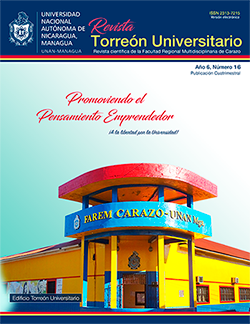The learning schemes: Kant y Piaget. Philosophical-Psychological introduction
DOI:
https://doi.org/10.5377/torreon.v6i16.6557Keywords:
conceptual system, scheme, learning, phases, subject-objectAbstract
Deficiencies in the structuring, development, and functioning of mental schemes affect the daily lives of social agents. The main consequence of these failures is reflected in learning problems (in the broad sense), from merely technical problems to errors in logical-mathematical thinking, in social-critical thinking, and in the natural and artificial language skills: oral expression, written expression, reading comprehension and grammar).
Studying human learning schemes shows that man and reality are dynamic and complex. Therefore, it can be said that human action and learning are constructed from an individual or collective poly-symbiotic social context that is in the discourse and allows explicitly structured learning schemes from four subschemas of action: conceptual-factual, linguistic, sociocultural and technical-procedural, that work in unison, although in different order when they come into contact with practical or theoretical learning situations.
The current origin of schema theory comes with Kant, who, in his conceptual system, develops a theoretical vision on these. Thus, part of the need to understand how it is possible for an object to be conceptualized by the mind and creates the concept of the original schema as a category that makes possible non-empirical representation, but the intelligent and sensible representation of objects in concepts. This term, doubly homogeneous, implies the category of time, the relations among representations and representations, in other words, is a microsystem that allows the categorization of phenomena as concepts objects of knowledge. The method which follows the understanding of this scheme, it is called schematism of the correct understanding.
Based on the ideas of Kant and the contributions of a French specialist, Piaget, he places the concept of the schema as a central and evolutionary term, which allows describing the subject's action during a specific learning situation, therefore, to explain the cognitive functioning of the subject. For this reason, it can be observed, throughout the Piagetian work, two fundamental theses to explain the subject-object interaction that uses the concept schema directly related to the action, which allowed him to make it explicit.
Downloads
5204
PDF 1151
Downloads
Published
How to Cite
Issue
Section
License
Los autores que publican en esta revista están de acuerdo con los siguientes términos.
- El autor o los autores de los artículos, ensayos o investigaciones conceden a la Universidad Nacional Autónoma de Nicaragua, Managua (UNAN-Managua) los derechos de edición (copyright) del trabajo enviado, por consiguiente la Universidad cuenta con el derecho exclusivo para publicar el artículo durante el periodo completo de los derechos de autor.
- Estos derechos de autor/ autores autorizan a la Revista Torreón Universitario y a la Universidad editar y divulgar/publicar el artículo en dicha Revista, incluyendo reproducción impresa y electrónica, el almacenamiento, recuperación y cualquier otro tipo de publicación, y fuentes de información secundaria como servicios de resúmenes y bases de datos, así mismo la facultan a proteger el artículo contra el uso no autorizado para su difusión por medios impresos o electrónicos (PDF, HTML, EPUB, XML u otros).
Licencia para el uso del contenido
La revista hace uso de la Licencia Creative Commons Atribución-NoComercial-SinDerivar 4.0 Internacional.
Bajo esta declaración:

Este revista está sujeta a una licencia de Creative Commons Reconocimiento-NoComercial-SinObraDerivada 4.0 Internacional. Puede ser copiada, distribuida y transmitida públicamente siempre y cuando se cite al autor y la fuente (Revista Torreón Universitario), no debe modificarse ni utilizarse con ningún fin comercial. La licencia completa se puede consultar en http://creativecommons.org/licenses/by-nc-nd/4.0/.



